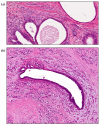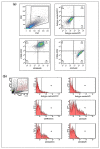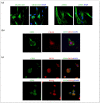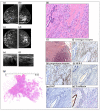Does Diffusely Infiltrating Lobular Carcinoma of the Breast Arise from Epithelial-Mesenchymal Hybrid Cells?
- PMID: 37445938
- PMCID: PMC10341583
- DOI: 10.3390/ijms241310752
Does Diffusely Infiltrating Lobular Carcinoma of the Breast Arise from Epithelial-Mesenchymal Hybrid Cells?
Abstract
Classic diffusely infiltrating lobular carcinoma has imaging features divergent from the breast cancers originating from the terminal ductal lobular units and from the major lactiferous ducts. Although the term "invasive lobular carcinoma" implies a site of origin within the breast lobular epithelium, we were unable to find evidence supporting this assumption. Exceptional excess of fibrous connective tissue and the unique cell architecture combined with the aberrant features at breast imaging suggest that this breast malignancy has not originated from cells lining the breast ducts and lobules. The only remaining relevant component of the fibroglandular tissue is the mesenchyme. The cells freshly isolated and cultured from diffusely infiltrating lobular carcinoma cases contained epithelial-mesenchymal hybrid cells with both epithelial and mesenchymal properties. The radiologic and histopathologic features of the tumours and expression of the mesenchymal stem cell positive markers CD73, CD90, and CD105 all suggest development in the direction of mesenchymal transition. These hybrid cells have tumour-initiating potential and have been shown to have poor prognosis and resistance to therapy targeted for malignancies of breast epithelial origin. Our work emphasizes the need for new approaches to the diagnosis and therapy of this highly fatal breast cancer subtype.
Keywords: biomarkers; breast neoplasms; early detection of cancer; histopathology technology; interdisciplinary communication; mammography; neoplastic stem cell; pathologists; patient care; precision oncology.
Conflict of interest statement
The authors declare no conflict of interest.
Figures









Similar articles
-
Breast cancers originating from the terminal ductal lobular units: In situ and invasive acinar adenocarcinoma of the breast, AAB.Eur J Radiol. 2022 Jul;152:110323. doi: 10.1016/j.ejrad.2022.110323. Epub 2022 May 10. Eur J Radiol. 2022. PMID: 35576721 Clinical Trial.
-
Breast cancers originating from the major lactiferous ducts and the process of neoductgenesis: Ductal Adenocarcinoma of the Breast, DAB.Eur J Radiol. 2022 Aug;153:110363. doi: 10.1016/j.ejrad.2022.110363. Epub 2022 May 18. Eur J Radiol. 2022. PMID: 35605334
-
The challenging imaging and histopathologic features of diffusely infiltrating breast cancer.Eur J Radiol. 2023 Apr;161:110754. doi: 10.1016/j.ejrad.2023.110754. Epub 2023 Feb 25. Eur J Radiol. 2023. PMID: 36868061 Clinical Trial.
-
Molecular and morphologic distinctions between infiltrating ductal and lobular carcinoma of the breast.Breast J. 2007 Mar-Apr;13(2):172-9. doi: 10.1111/j.1524-4741.2007.00393.x. Breast J. 2007. PMID: 17319859 Review.
-
Differentiation of tumours of ductal and lobular origin: II. Genomics of invasive ductal and lobular breast carcinomas.Biomed Pap Med Fac Univ Palacky Olomouc Czech Repub. 2005 Jun;149(1):63-8. doi: 10.5507/bp.2005.006. Biomed Pap Med Fac Univ Palacky Olomouc Czech Repub. 2005. PMID: 16170390 Review.
Cited by
-
Glucocorticoid Receptor Activation in Lobular Breast Cancer Is Associated with Reduced Cell Proliferation and Promotion of Metastases.Cancers (Basel). 2023 Sep 22;15(19):4679. doi: 10.3390/cancers15194679. Cancers (Basel). 2023. PMID: 37835373 Free PMC article.
References
-
- World Health Organization . Breast Cancer Screening. IARC, International Agency for Research on Cancer; Lyon, France: 2016.
-
- Duffy S.W., Tabár L., Yen A.M., Dean P.B., Smith R.A., Jonsson H., Törnberg S., Chiu S.Y., Chen S.L., Jen G.H., et al. Beneficial Effect of Consecutive Screening Mammography Examinations on Mortality from Breast Cancer: A Prospective Study. Radiology. 2021;299:541–547. doi: 10.1148/radiol.2021203935. - DOI - PubMed
-
- Tabár L., Dean P.B., Yen A.M., Tarján M., Chiu S.Y., Chen S.L., Fann J.C., Chen T.H. A Proposal to Unify the Classification of Breast and Prostate Cancers Based on the Anatomic Site of Cancer Origin and on Long-term Patient Outcome. Breast Cancer. 2014;8:15–38. doi: 10.4137/BCBCR.S13833. - DOI - PMC - PubMed
-
- Tabar L., Dean P.B., Chen S.L., Chen H.H., Yen A.M., Fann J.C. Invasive Lobular Carcinoma of the Breast: The Use of Radiological Appearance to Classify Tumor Subtypes for Better Prediction of Long-Term Outcome. J. Clin. Exp. Pathol. 2014;4:179. doi: 10.4172/2161-0681.1000179. - DOI
MeSH terms
Grants and funding
LinkOut - more resources
Full Text Sources
Medical
Research Materials

